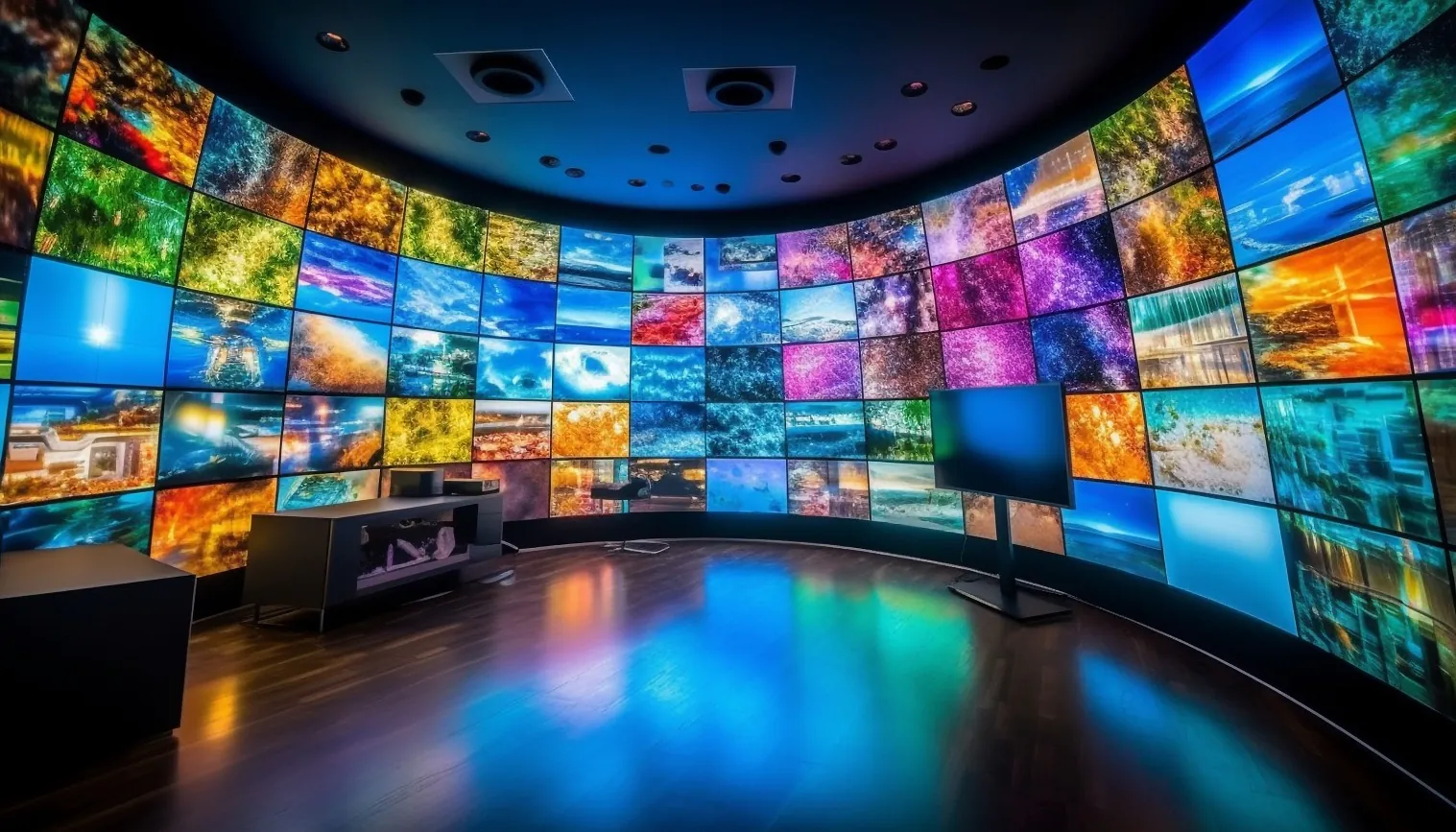What is a Video Wall
Are you looking for a new way to advertise your business? Perhaps you want a modern method of keeping everyone informed, whether it be your customers, clients, or your employees? Or perhaps you want an engaging form of entertainment for your reception areas? A video wall can help you achieve these and more. This is because a video wall is a powerful tool, and there are a lot of possibilities that come with it. So what is a video wall? How does it work, and how can you use it?
What is a video wall?
To put it simply, a video wall is a display collection or setup that consists of multiple screens arranged together to create a larger single display surface. Common display technologies used for a video wall include LCD (liquid crystal display) or LED (light-emitting diode) panels, digital signage, computer monitors, projection screens, laser displays, and more.
These screens can be tiled or grouped together in various configurations to form a newer, larger, and seamless display. Video walls are often used in various settings and for a multitude of applications. This includes settings like control rooms, public spaces, entertainment venues, stadiums, studios, healthcare establishments, and corporate environments for purposes such as advertising, information dissemination, monitoring, immersive experiences, and more. A video wall offers high brightness, clarity, and versatility, which makes it suitable for showcasing dynamic content to large audiences.
How does a video wall work?
A video wall works by combining multiple individual display screens into a single cohesive unit. As a singular unit, it can display images, videos, and texts across the entire surface.
Here's a basic overview of how a video wall works:
- Display panels: Video walls consist of individual display panels, typically LCD or LED screens. These panels or signage are usually thin and lightweight, with narrow bezels that minimize the gap between each display. This makes a video wall easy to arrange and install.
- Display configuration: The individual display panels are arranged in a grid or other configurations to form the video wall. They are connected to the video wall controller either directly or via a network.
- Content source: The content to be displayed on the video wall is typically sourced from various devices, such as computers, media players, or video sources like cameras. This content can include images, videos, texts, live feeds, or data visualization.
- Video wall controller: A video wall controller is the central component that manages the content displayed on the video wall. It takes input signals from various sources, such as computers, media players, or video cameras, and processes them for output onto the video wall.
- Content distribution: The video wall controller then distributes the content across the individual display panels according to the desired layout or configuration. This can involve scaling and formatting the content to fit the resolution and aspect ratio of each panel on the video wall.
- Seamless integration: The video wall controller ensures that the content seamlessly transitions across the individual display panels. This creates the illusion of a single large display surface functioning as a single unit without noticeable gaps or interruptions.
- Control and management: Video walls often come with software interfaces or control systems that allow users to manage and control the content displayed, adjust settings such as brightness and color, and monitor the status of the video wall components.
In conclusion, for a video wall to work, both hardware and software components work together. As the video wall control interface communicates with the display panels, users will be able to utilize this technology for advanced display purposes.
What is the difference between a video wall and a TV?
Many business professionals and consumers might confuse a video wall with a television unit. Some might also think that they’re the same or that a video wall is unnecessary when there is a TV. However, a video wall and a TV are two different things and can be used for different applications.
The main differences between a video wall and a TV are in their purpose, size, scalability, and flexibility.
Purpose
TV: A television is typically designed for personal entertainment in a home or small-group setting. It's meant for watching broadcast television, streaming content, presenting data and information, or playing video games.
Video wall: A video wall, on the other hand, is designed for large-scale display applications in commercial, public, corporate, entertainment, or institutional settings. It's used for purposes such as advertising, information display, monitoring, and other immersive experiences.
Size
TV: TVs are available in various sizes, ranging from small screens suitable for personal use to larger screens for home theaters or corporate settings. However, even the largest TVs typically have physical limitations on their size due to manufacturing constraints.
Video Wall: Video walls can be constructed to virtually any size by tiling together multiple individual display screens or panels. Because of this, users are able to create extremely large and visually impactful displays that can span entire walls or even entire buildings.
Scalability
TV: TVs are typically standalone devices that operate independently. While it's possible to connect multiple TVs to create a larger display, the process can be cumbersome, and synchronization may be challenging. A TV might also be a little bulkier and heavier, which will be harder to manipulate into a larger display setup.
Video Wall: Video walls are inherently scalable and modular. Additional display panels can be added or removed to adjust the size of the video wall as needed. Video wall controllers can easily synchronize and manage content across multiple panels as well. This ensures seamless integration for whatever application is needed.
Flexibility
TV: Since TVs are mostly for personal use and small to medium-sized settings, they are designed for specific viewing distances and angles. Their configurations are also generally fixed. Because of this, they may have limited flexibility in terms of mounting options or display orientation.
Video Wall: Video walls offer more flexibility than TVs, especially in terms of configuration, orientation, and installation options. They can be mounted in landscape or portrait mode, in curved or flat configurations, and even on uneven surfaces or non-standard shapes.
At the end of the day, a video wall is a good tool for a lot of businesses and establishments. With its flexibility and scalability, businesses can find a horde of applications for a video wall to enhance efficiency, engagement, marketing, and more.
How can businesses use a video wall?
Many businesses across various industries can benefit from using a video wall. They can use this to enhance their operations, communication, marketing campaigns, and customer engagement.
Here are some notable examples of businesses that can use video walls and how they can utilize them:
#1 Retail Stores
Various retailers can use video walls to showcase product advertisements, promotions, and branding messages in-store. Different types of retail signage are already being used by some. Retailers such as grocery stores, big box stores, department stores, electronics stores, and more can take it to another level and take advantage of a video wall. They can create interactive displays to engage customers, provide product information, and facilitate virtual try-ons. Video walls can also be used for digital signage to display pricing, sales information, and store navigation.
#2 Hospitality Industry
Hotels and resorts can use a video wall as well. It can be placed in lobbies, conference rooms, and specific event spaces. These video walls can welcome guests, display event schedules, and promote hotel and resort amenities.
Restaurants and bars can also use video walls for digital menus, entertainment, and ambiance enhancement. Convention centers and event venues, on the other hand, can use video walls for event branding, sponsor promotions, and directional signage.
#3 Corporate Offices
Corporate offices can use video walls in reception areas, conference rooms, and collaboration spaces for corporate branding, internal communications, and presentations. These video walls can be utilized for real-time data visualization, monitoring of key performance metrics, enhancing internal communication and announcements and displaying news updates. They can also facilitate remote collaboration by connecting multiple offices through video conferencing systems.
#4 Entertainment Venues
Entertainment centers can also utilize a video wall. Movie theaters, stadiums, and concert halls can be used it for digital advertising, event promotions, and pre-show entertainment.
Meanwhile, museums, galleries, and exhibition spaces can use video walls to showcase digital art installations, immersive and educational tour experiences, and interactive exhibits.
#5 Healthcare Facilities
Healthcare facilities like hospitals and clinics can use video walls in waiting areas and patient rooms as well. They can display health education content, appointment schedules, and wayfinding information. Medical facilities can also utilize video walls for telemedicine consultations, medical imaging, and surgical training.
#6 Education Institutions
Schools, colleges, and universities can benefit greatly from a video wall. They can use video walls in classrooms, libraries, and common areas for educational content delivery, announcements, and student engagement. Academic establishments can also facilitate remote learning by connecting classrooms through video conferencing systems displayed on video walls.
#7 Transportation Hubs
And of course, transportation hubs can also take advantage of a video wall. Airports, train stations, and bus terminals can use video walls for passenger information displays, flight/train/bus schedules, and wayfinding assistance. Meanwhile, they can also provide entertainment and advertising opportunities for travelers during wait times.
What are the benefits of a video wall?
Businesses can fully utilize a video wall in their operations in various ways. When used effectively, businesses can reap the benefits of a large and dynamic display screen.
So what are the benefits of a video wall? Here are some of them:
High Impact Visuals
Video walls provide a visually striking and immersive experience for customers or clients. They are capable of showcasing dynamic content with high brightness, contrast, and clarity. And best of all, they grab attention and engage the viewers effectively.
Scalability
Video walls can be easily scaled to fit any space or achieve size requirements by adding or removing display panels. This scalability makes them suitable for several applications, ranging from small retail environments to large-scale public installations.
Flexibility
Video walls offer immense flexibility as well. This includes factors like configuration, orientation, and content management. They can be mounted in landscape or portrait mode, curved or flat configurations. Of course, they can also display a variety of content types, including images, videos, texts, marketing posters, live feeds, data visualization, and any other kind of information.
Content Customization
Video walls allow for dynamic content customization and scheduling as well. Content can be easily updated, changed, or scheduled to suit specific events, promotions, or information dissemination needs.
Information Dissemination
Video walls are effective tools for information dissemination. This is incredibly beneficial when it comes to public spaces, government offices, healthcare establishments, corporate environments, control rooms, and other educational institutions. They can display real-time data, news updates, announcements, customer updates, wayfinding information, transformation or weather updates, advertising materials, and a lot more.
Brand Promotion
A video wall also serves as a powerful branding tool. This allows businesses to showcase their products, services, and brand messaging in a visually compelling manner. They can enhance brand visibility and leave a lasting impression on customers and clients. This can strengthen customer relationships and loyalty as well.
Increased Engagement
The visually captivating nature of video walls captivates audiences and increases engagement levels. Whether used for entertainment, education, or advertising, video walls have been shown to hold viewers' attention for longer periods compared to traditional static displays or paper materials.
Remote Management
Many video wall systems offer remote management capabilities. This allows users to control and monitor the video wall from a central location. This simplifies maintenance, troubleshooting, and content updates, especially in large-scale deployments with multiple video walls across different locations or a large display spanning an entire story or building.
SOLUM Signage as a Video Wall Solution
SOLUM Group, as a global leader in electronic shelf label solutions, also offers a Digital Signage Solution for businesses. The SOLUM Digital Signage is developed for different kinds of businesses and retail settings.
Newton TOUCH by SOLUM can be a powerful marketing and revenue-generating platform. As a display solution, it can highlight product videos, instructional demos, product coupons, in-store promotions, product catalogs, and more. Not only this, but it can also spread information for the business, such as navigation or mapping guides, QR codes, digital menus, and more. This means that the Newton TOUCH can be used by a variety of businesses and can be used to create a larger video wall.
Newton TOUCH features include:
- Interactive displays
- 23” and 29” variations
- IPS (in-plane switching) technology
- Up to 16.7 million colors
- Anti-glare coating
- High-performance processors
- An intuitive CMS platform
This digital signage solution can solve a lot of problems and enhance operations for a lot of establishments.
If you think you need a video wall for your business, SOLUM Signage is a good start. Talk to SOLUM Group experts today and see how signage and video wall solutions can level up your business.











